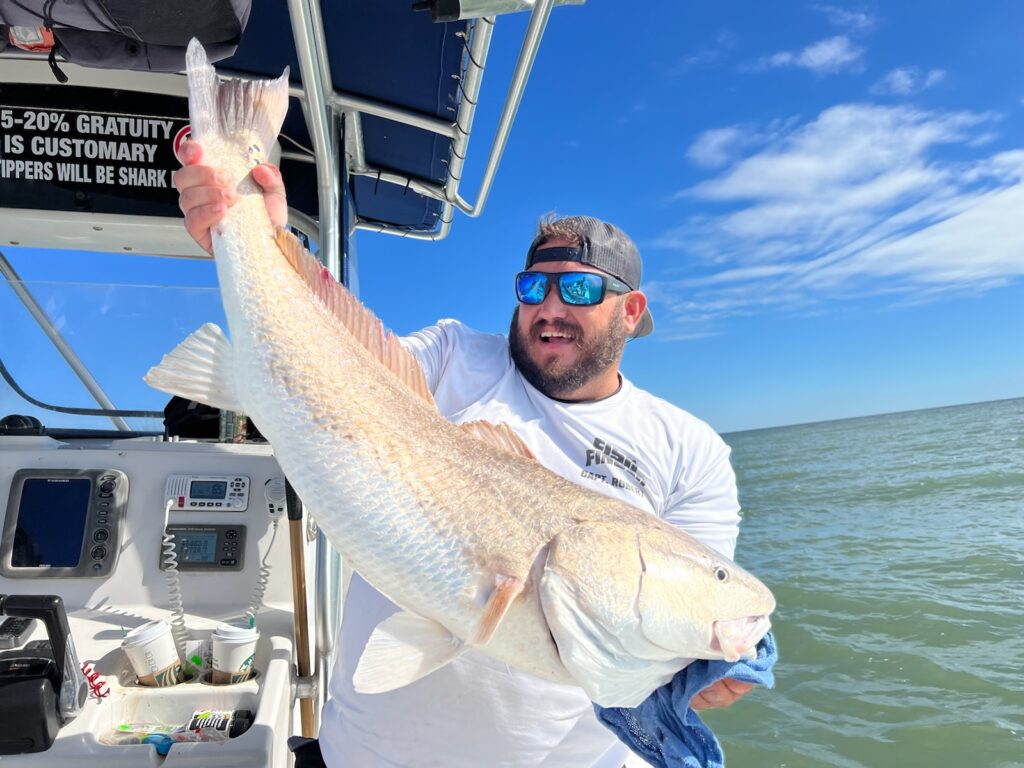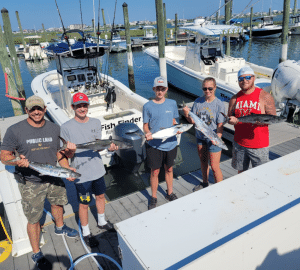Fish of Murrells Inlet, SC: How to identify Red Drum
Welcome to the fascinating world of the Red Drum! With its scientific name and unique features, identifying this spectacular fish in the serene waters of Murrells Inlet, SC, can be an exhilarating experience for any angler. The Red Drum, also known as the “bull redfish,” thrives in the lush habitats of Murrells Inlet, offering an ideal setting for a memorable fishing adventure. To delve deeper into the secrets of spotting this prized fish, we’ll be referring to the South Carolina Department of Natural Resources (SC DNR) for valuable insights. Additionally, don’t forget to check out our Tips and Tricks page for expert fishing advice to enhance your experience and reel in some impressive catches!
Introduction to Red Drum
The Red Drum and Murrells Inlet
The Red Drum, a robust and resilient fish, has become synonymous with the rich waters of Murrells Inlet. This area is a haven for angler enthusiasts, partly due to the thriving population of Red Drum, which is both a challenge and a delight to catch. Their presence in Murrells Inlet is not by chance; the inlet’s ecosystem provides the perfect balance of food and shelter, making it a prime spot for these fish. Anglers in Murrells Inlet often come across Red Drum while fishing along the marsh edges, flats, and oyster beds. The area’s mild climate and the mix of fresh and saltwater contribute to the ideal conditions for Red Drum to feed and grow. Identifying Red Drum in these waters not only requires a keen eye but also an understanding of their behavior and habitat, which is what we aim to impart to those ready to cast their lines.
Understanding Fish Habitats in Murrells Inlet, SC
The Unique Environment of Murrells Inlet
Murrells Inlet, known as the “Seafood Capital of South Carolina,” boasts an environment that is as diverse as it is dynamic. This estuarine area, with its intermingling fresh and salt waters, creates a brackish habitat rich in nutrients, making it a fertile ground for various fish species, particularly the Red Drum. The inlet’s marshy areas, lined with Spartina grass, provide a nursery for young fish, while the deeper channels and adjacent offshore waters offer a sanctuary for mature fish. The tidal creeks and oyster reefs enrich the aquatic environment, supporting a food web that sustains the Red Drum and other fish of Murrells Inlet. This unique environmental setup not only supports an abundant marine life but also attracts anglers of all skill levels seeking the thrill of a diverse catch in these prolific waters.
Red Drum and their Preferences
Red Drum are discerning when it comes to their habitat, showing clear preferences that can guide anglers to their locations. They are typically found in shallow waters, which makes the marshes and estuaries of Murrells Inlet a perfect home. Young Red Drum, known as “puppy drum,” often stay in these protective shallows where food is plentiful and predators are fewer. As they mature, they venture into deeper waters but remain close to the estuarine systems they favor. Red Drum have a particular appetite for crustaceans like crabs and shrimp, which are abundant in Murrells Inlet, and they also feed on small fish and mollusks. Their feeding habits are influenced by the tide, with many anglers noting increased activity during the ebbing and flowing of the inlet’s waters. Understanding these preferences is key to identifying red drum, making knowledge of their behavior as critical as the tackle used to catch them.
Practical Guide to Identifying Red Drum
Key Identification Features
Identifying Red Drum involves looking for specific features that distinguish them from other fish in Murrells Inlet. A key characteristic of Red Drum is their copper-bronze body color and a distinct spot or multiple spots at the base of the tail fin. Frequently, this spot is used by predators to target the tail instead of the head, allowing the Red Drum a better chance to escape. Additionally, they have an elongated body with a blunt nose and a sloped forehead. Their mouth is located on the bottom of their head, which aids in feeding off the bottom. Red Drum make a distinctive drumming sound, which is produced by muscles rubbing against their air bladder – this is also how they got their name. When you’re out on the water, these identification tips will help you recognize a Red Drum and add to the success of your fishing adventure.
Distinguishing Red Drum from Similar Species
When identifying Red Drum, it’s crucial to distinguish them from similar species that inhabit Murrells Inlet. One common look-alike is the Black Drum, which also has a barbel on its lower jaw and can produce a drumming sound. However, the Black Drum has vertical black stripes on its body as a juvenile, which fade as it matures, while the Red Drum maintains its signature spot. Another species often confused with the Red Drum is the Spotted Seatrout. The Seatrout, though, has a more elongated and slender body and lacks the distinctive tail spot. Additionally, Seatrout have prominent canine teeth, which Red Drum do not have. When fishing in Murrells Inlet, observing these subtle differences is important for the proper identification and ethical treatment of each species, ensuring a responsible and rewarding fishing experience.
Resources and Further Reading
The South Carolina DNR Resource
The South Carolina Department of Natural Resources (SC DNR) is an invaluable resource for anyone interested in identifying Red Drum and understanding the fish of Murrells Inlet. The SC DNR provides extensive information on Red Drum, including their biology, habitat, and behavior, which is essential for both novice and experienced anglers. Their resources include detailed guides, fishing regulations, and conservation programs aimed at sustaining the Red Drum population. Utilizing the SC DNR’s resources can not only improve your chances of a successful catch but also contribute to responsible fishing practices that protect Murrells Inlet’s marine ecosystem. By staying informed with the latest data and guidelines from the SC DNR, anglers can enjoy the thrill of fishing while supporting the conservation efforts that keep the Red Drum population healthy and thriving.

Fishing Tips and Tricks from Experts
For those eager to master the art of fishing in Murrells Inlet, expert advice can be a game-changer. Experienced anglers often share tips and tricks that are tailored to catching Red Drum. One such tip is to fish during the changing tides, as Red Drum are more active and feeding when the water is moving. Using the right bait is also critical; live bait such as shrimp or mullet can be particularly effective, as it appeals to the Red Drum’s natural diet. Experts also recommend paying attention to the environment — Red Drum often congregate near structures like docks, oyster beds, and drop-offs. Casting your line in these areas increases your chances of a catch. Additionally, maintaining a stealthy approach in shallow waters can prevent scaring the fish away. By incorporating these expert techniques, you’re more likely to experience the thrill of catching the elusive Red Drum in Murrells Inlet. Visit Our Tips and Tricks Page for tips like this.
Conclusion: Enrich Your Murrells Inlet Fishing Experience
In conclusion, identifying Red Drum in the waters of Murrells Inlet can significantly enrich your fishing experience. Armed with the knowledge of their key identification features and habitat preferences, you’re now better equipped to spot and catch these impressive fish. Remember to utilize the resources provided by the South Carolina DNR and heed the advice from seasoned anglers to not only enjoy your fishing adventure but also to contribute to the sustainability of the local fish population. Murrells Inlet offers a unique and bountiful fishing environment that, when approached with respect and understanding, can yield not just a great catch but also lasting memories. Whether you’re a seasoned pro or a family looking for adventure, the thrill of reeling in a Red Drum is an experience that’s simply unmatched. So grab your gear, apply your new insights, and head out to the waters — the Red Drum are waiting.




